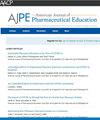TikTok as a tool for learning top 300 drugs
IF 3.5
4区 教育学
Q1 EDUCATION, SCIENTIFIC DISCIPLINES
引用次数: 0
Abstract
Objective
The study aimed to assess the influence of student-generated TikTok videos on quiz performance and to evaluate student perspectives on this tool for learning the top 300 drug facts.
Methods
This mixed-methods cohort study was conducted in Fall 2021 with second-year pharmacy (P2) students (n = 169). Students could create videos in small groups tasked with developing and viewing TikTok videos or use traditional study methods (top 300 drugs flashcards). Pre and poststudy surveys and focus groups assessed perceptions and demographics. Quiz performance was compared between TikTok creators, viewers, and nonparticipants using Kruskal-Wallis tests, with thematic analysis applied to qualitative data.
Results
The survey response rate was 94.1% (159/169). A total of 112 students watched TikTok videos to study (“viewers”; 70.4%), while 47 did not (“nonviewers”; 29.6%); 106 students created videos (“creators”; 66.7%), while 53 did not (“noncreators”; 33.3%). No significant difference in quiz scores was noted between TikTok viewers and nonviewers. Similarly, no significant difference in quiz scores was observed between TikTok creators and noncreators. Thematic analysis revealed that creating videos helped with understanding but was time-consuming, and viewing the videos for study purposes was reportedly distracting.
Conclusion
Student perceptions supported the educational value of TikTok videos, but neither producing nor watching significantly affected quiz performance. Although creating and viewing these videos had benefits, such as making studying more fun and accessible, there were also some limitations, including the laborious process of creating the videos and distractions.
TikTok是学习前300种药物的工具。
目的:本研究旨在评估学生制作的TikTok视频对测验成绩的影响,并评估学生对该工具学习前300个药物事实的看法。方法:该混合方法队列研究于2021年秋季在二年级学生药师中进行(n=169)。学生可以小组创作视频,负责开发和观看TikTok视频,或者使用传统的学习方法(前300种药物抽认卡)。研究前后的调查和焦点小组评估了人们的看法和人口统计数据。使用Kruskal-Wallis测试比较了抖音创作者、观众和非参与者的测验表现,并对定性数据进行了主题分析。结果:调查回复率为94.1%(159/169)。共有112名学生观看TikTok视频进行学习(“观众”;70.4%),而47%没有(“非观众;”29.6%);106名学生制作视频(“创作者”;66.7%),而53人没有(“非创造者;”33.3%)。看TikTok的人和不看TikTok的人在测验分数上没有显著差异。同样,在抖音创作者和非创作者之间,测试分数也没有显著差异。专题分析显示,制作视频有助于理解,但耗时,据报道,为了学习而观看视频会分散注意力。结论:学生的认知支持TikTok视频的教育价值,但制作和观看都没有显著影响测试成绩。虽然制作和观看这些视频有好处,比如让学习变得更有趣、更容易,但也有一些限制,包括制作视频的过程很费力,而且会让人分心。
本文章由计算机程序翻译,如有差异,请以英文原文为准。
求助全文
约1分钟内获得全文
求助全文
来源期刊
CiteScore
4.30
自引率
15.20%
发文量
114
期刊介绍:
The Journal accepts unsolicited manuscripts that have not been published and are not under consideration for publication elsewhere. The Journal only considers material related to pharmaceutical education for publication. Authors must prepare manuscripts to conform to the Journal style (Author Instructions). All manuscripts are subject to peer review and approval by the editor prior to acceptance for publication. Reviewers are assigned by the editor with the advice of the editorial board as needed. Manuscripts are submitted and processed online (Submit a Manuscript) using Editorial Manager, an online manuscript tracking system that facilitates communication between the editorial office, editor, associate editors, reviewers, and authors.
After a manuscript is accepted, it is scheduled for publication in an upcoming issue of the Journal. All manuscripts are formatted and copyedited, and returned to the author for review and approval of the changes. Approximately 2 weeks prior to publication, the author receives an electronic proof of the article for final review and approval. Authors are not assessed page charges for publication.

 求助内容:
求助内容: 应助结果提醒方式:
应助结果提醒方式:


